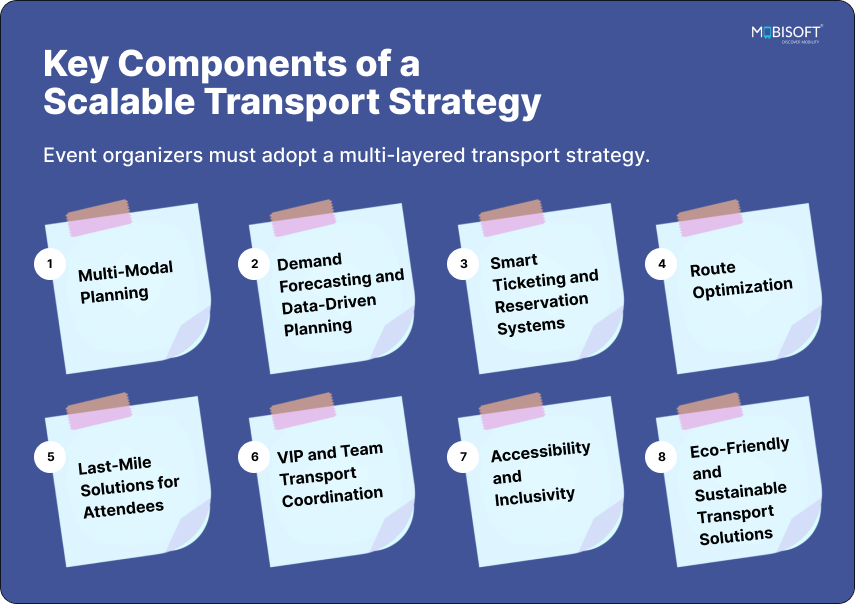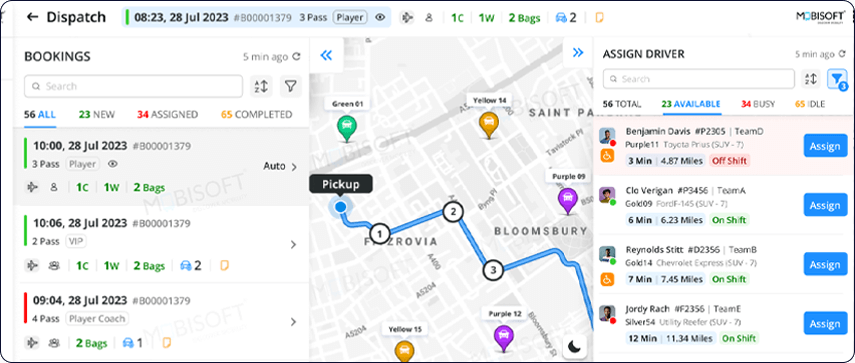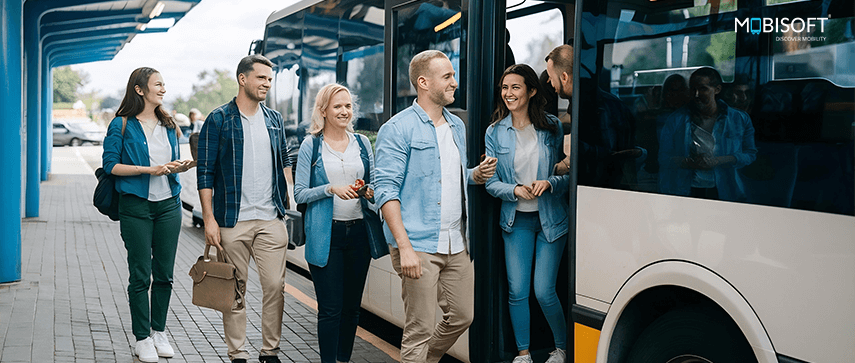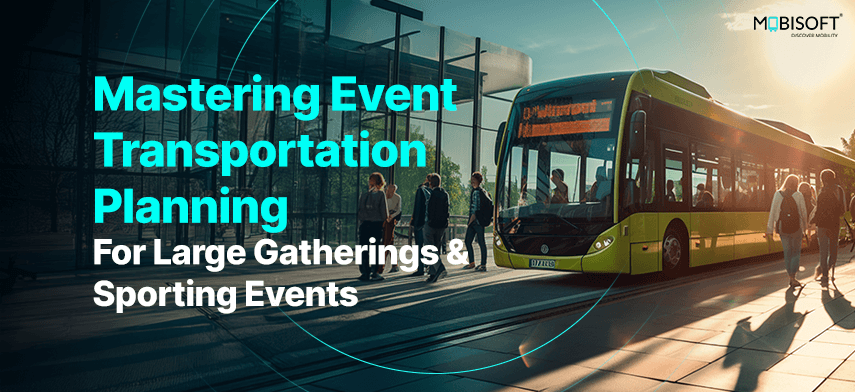Large events pull in big crowds. Whether it’s the FIFA World Cup or a global summit, thousands of people show up. Event transportation planning is just one part of the job. Getting everyone there on time and without stress is another.
If you don’t have a scalable transport strategy, things can go wrong fast. Traffic builds up. Delays stack. Frustrated attendees start sharing complaints online. And your team struggles to fix problems that could’ve been avoided.
A good transport plan helps attendees, athletes, VIPs, and staff get to the event on time. It ensures event parking solutions and comfort.
So, how do you build one that works seamlessly? This guide breaks it down for you.
The Challenges of Large-Scale Event Transportation

Managing transport for large crowds is not easy. It comes with complex logistical challenges like:
Traffic Congestion
- High traffic density near venues slows down movement.
- Delays frustrate attendees and may cause security risks.
- Emergency vehicles may struggle to pass through blocked roads.
Traffic management for sports events is especially critical to avoid bottlenecks.
Last-Mile Connectivity Issues
- Public transit hubs (train stations, bus stops) are often far from the event.
- Attendees without personal vehicles face trouble reaching the venue.
- Walking paths are often unclear or poorly marked.
Inconsistent Demand and Crowd Surges
- Peak periods (before and after an event) create sudden demand spikes.
- Insufficient transport options cause overcrowding.
On-demand transportation for events can help mitigate these surges by providing flexible options.
Accessibility and Inclusivity Concerns
- Poor planning can lead to the exclusion of differently-abled attendees.
- You must plan for wheelchairs, strollers, and senior citizens.
VIP Transport Needs
- Delays in VIP transport can disrupt entire event schedules.
- VIPs and athletes need special transport lanes, security escorts, and luxury vehicles.
Looking for best VIP transportation software solutions to streamline these logistics?
Environmental Impact
- Large events may cause carbon emissions and pollution.
- Without eco-friendly transport solutions, your event may leave a large carbon footprint.

Key Components of a Scalable Transport Strategy

Event organizers must adopt a multi-layered transport strategy. It prioritizes efficiency, scalability, and sustainability. Here’s how:
Multi-Modal Planning
- Offer public transport, shuttles, and ride-share.
- Create smooth transfers between airports, train stations, and venues.
- Develop clear wayfinding systems with digital and physical signage. Smart transportation for large gatherings can help streamline this process.
Demand Forecasting and Data-Driven Planning
- Use data, AI-powered analytics, and real-time transport solutions for events to predict crowd flow.
- Deploy adaptive transport models that adjust to real-time attendance patterns.
- Coordinate with local authorities and transportation agencies to manage the crowd efficiently.
For more advanced event transportation planning, check out our solution here: Event Transportation Planning.
Smart Ticketing and Reservation Systems
- Build online ticketing platforms that include transportation passes.
- Let users pre-book shuttles, VIP transport, and public transit passes.
- Offer cashless and contactless payment options to make the process smoother.
For streamlining this process, event booking software can be a great solution.
Route Optimization
- Create special lanes for shuttles, public transport, and emergency vehicles.
- Use smart traffic signals and AI-powered monitoring to manage traffic flow.
- Give drivers real-time updates to reroute vehicles if needed.
Last-Mile Solutions for Attendees
- Provide shuttle buses, e-scooters, and bike-sharing options.
- Ensure pedestrian-friendly walking routes with clear wayfinding.
- Optimize drop-off and pickup points for ride-sharing services like Uber and Lyft.
VIP and Team Transport Coordination
- Dedicated transport lanes for VIPs, media personnel, and athletes.
- Secure transport with police escorts for high-profile guests.
- Private helicopter or luxury vehicle transfers for elite attendees.
For a deeper dive into the complexities of transportation logistics for VIPs, athletes, and high-profile guests, check out our blog on Seamless Travel for VIPs, Athletes & High-Profile Guests.
Accessibility and Inclusivity
- Ensure wheelchair-friendly buses, shuttles, and parking spaces.
- Provide assistance staff at transport hubs and event venues.
- Develop an inclusive digital booking system for transport.
Eco-Friendly and Sustainable Transport Solutions
- Use electric and hybrid shuttle buses to reduce emissions.
- Carbon offset programs for event transportation.
- Incentives for attendees who use public transport for major events or carpooling.
Technology and Innovation in Event Transport Management
AI and Machine Learning for Traffic Management
- Predict crowd surges and reroute vehicles in real-time.
- Minimize delays with data-backed adjustments.
For more insights, check out our AI in Event Transportation: Future of Mobility Solutions blog.
Mobile Apps for Seamless Navigation

- Event transport apps with real-time transport solutions for events, route maps, and estimated arrival times.
- Push notifications for live traffic and transport changes.
- Integrated ride-hailing and shuttle booking features.
RFID & QR Code-Based Ticketing
- Touchless entry to buses, trains, and VIP shuttles.
- Pre-paid transport passes linked to event tickets.
IoT-Enabled Fleet Management
- GPS tracking for event transport vehicles.
- Automated vehicle dispatching and fleet optimization.
Digital Twins for Scenario Planning
- Virtual simulations of event transport flow to test different strategies.
- Predictive modeling to prepare for worst-case scenarios.
Case Studies: Successful Event Transport Strategies
Olympics and World Cup
- London 2012 and Rio 2016 used integrated public transport.
- Dedicated lanes and smart scheduling helped avoid delays.
Music Festivals like Coachella

- Shuttle services for large gatherings and parking plans improved access.
- Ride-share zones reduced traffic.
NFL Super Bowl
- Early planning ensured smooth VIP and attendee transport.
- Special zones made entry and exit easier.
Smart Cities like Tokyo and Singapore
- Used advanced tech and data to manage transport.
- Real-time updates and seamless transit helped attendees. Sports event management software helps streamline transportation logistics for large sports events.
Best Practices for Event Organizers
Start Early
- Plan months ahead.
- Secure permits, police coordination, and transportation partnerships.
- Work with city officials and transit teams.
Put Attendees First
- Make it easy to find routes.
- Offer real-time updates on delays or changes.
Use Tech to Stay Flexible
- Let AI help you adjust in real-time.
- Monitor traffic and change routes as needed.
Balance Cost and Sustainability
- Choose efficient and eco-friendly transport solutions.
- Avoid overbooking or underusing transport.
Analyze and Improve
- Collect feedback and study traffic data.
- Use insights to do better next time.
Conclusion: Planning Starts Now
You can’t leave transport to chance when thousands of people are coming to your event.
A solid, scalable transport strategy is essential. Smart logistics, AI-enabled planning tools, and sustainable choices can keep things running smoothly. You’ll cut down delays, control costs, and ease traffic and congestion.
Get it right and attendees, VIPs, and staff will have a better experience from start to finish.
Not sure where to begin? Our team’s here to help. Let’s talk.





 March 10, 2025
March 10, 2025


